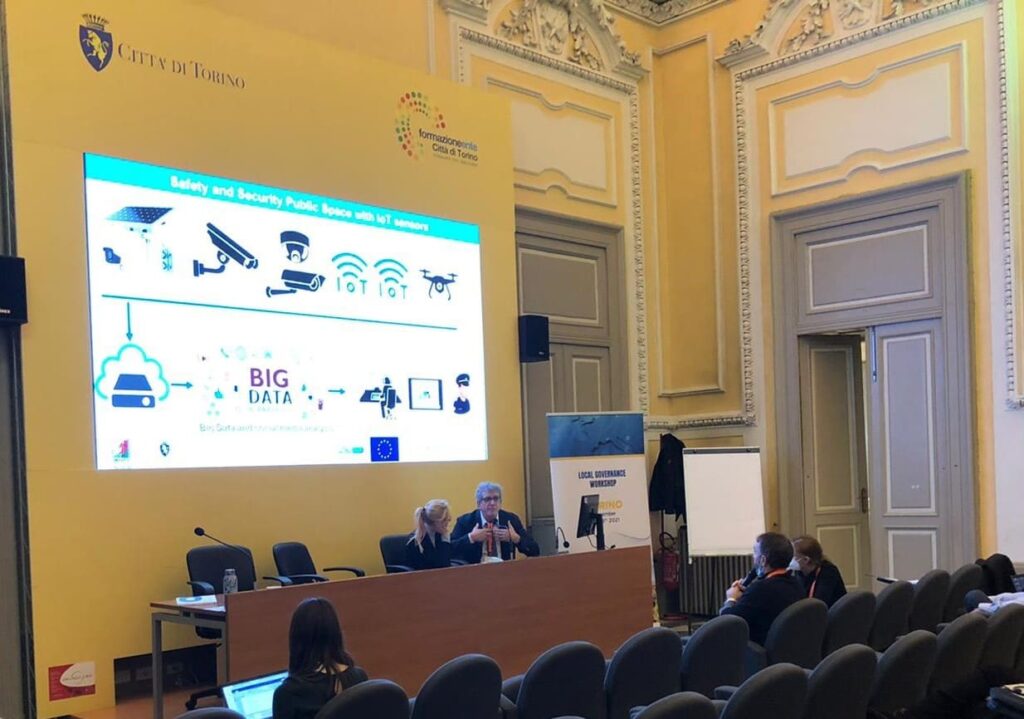Turin, Italy, November 2021 – The PACTESUR project, which is led by the city of Nice (France) and in which Efus is a partner, held a local governance workshop hosted by the partner city of Turin, on 17-18 November. The meeting gathered local security stakeholders, police representatives and security experts to discuss risk prevention, evacuation procedures and crisis management in public spaces.
It was PACTESUR’s third local governance workshop following Liège (Belgium), in May 2021, and Nice (France), in December 2019.




The challenge of keeping public spaces safe
The purpose was to discuss the strategy implemented by Turin to protect its public spaces on a daily basis but also during major events, and for the consortium (Nice, Liège, Turin, ANCI Piemonte, Métropole Nice-Côte-d’Azur and Efus) and representatives from the Expert Advisory Committee and the Associated Cities Group to share their experience.
On the first day, participants learned about the key aspects of the Turin pilot equipment – the use of big data and social media analysis for public space protection – and visited Piazza Vittorio Veneto with Gianfranco Todesco, Commander at the Technological Investigations Department of the Municipal Police of Turin. Representing Efus, Tatiana Morales and Marta Pellón Brussosa presented Efus’ strategic approach to urban security, a holistic approach based on an audit of the security situation on the ground that feeds into a strategy, which takes into account all the factors contributing to insecurity, including social ones, and involves all the relevant local stakeholders in order to prevent or mitigate crime or other forms of insecurity. (Watch the video illustrating this approach).
In the afternoon, participants learned and exchanged on practical experiences from the City of Turin with Massimo Norgia, a former Italian army doctor, Silvia Zanetti, Technical Coordinator of the Commission of Turin for safety & security, and Edoardo Mattiello, a security expert from the association of Italian cities ANCI Piemonte.
Piazza Vittorio Veneto, an example of big data and social media analysis
The demonstrator set up in Piazza Vittorio Veneto, a large square situated in the historic centre of the city, shows how technology can support decision-making during the planning and management of security in big public events. The equipment allows for crowd management thanks to a combination of wi-fi and bluetooth sensors, drones, CCTV and social data analytics. This visit also highlighted the importance of addressing security concerns as early as possible in the planning and design of a public space.

Leed’s Hostile Vehicle Mitigation scheme
With a view to fostering European exchanges, the visit was followed by a comparison with the Hostile Vehicle Mitigation (HVM) scheme of Leeds, which is one of the PACTESUR Associated Cities. Representing the city, Paul Seddon laid out its local security strategy for large events, in particular during the pre-planning and preparation phases. A Safety Advisory Group (SAG) meets before every event to draft a safety strategy and a communication plan, including how to minimise impacts on the community and how to coordinate all the relevant agencies so that events are safe and successful. Communication prior to the event is crucial, for example informing the public that bags will not be allowed within the premises. The UK’s National Counter Terrorism Security Office has also made available to the public guidance on increasing the protection of crowded places from a terrorist attack. It includes advice for the public on the steps they can take to keep safe in the rare event of a firearms or weapons attack.
Protecting urban public spaces: an evaluation of strengths and drawbacks
On the second day, participants re-assessed the evaluation of the Turin pilot equipment based on the visit to the demonstrator, compared it with other local practices and updated the recommendations drafted in March 2021.
- They discussed how to improve the already-drafted recommendations to local authorities on how to improve the planning, implementation and management of security devices to protect public spaces in Europe, in particular before installing them and on how to best manage and maintain them once they are installed.
- Participants also discussed the fact that security measures can sometimes fuel feelings of insecurity, especially when they are particularly visible in a public space. Indeed, a golden rule of security is that it should be invisible.
Experts and associated cities also had the opportunity to learn more about the handbook prepared by Edoardo Mattiello, which supports local authorities in managing security and safety during public events, and discussed the multi-agency approach to prevent violent extremism with Luca Guglielminetti, Ambassador for Italy of the Radicalisation Awareness Network (RAN). Isabella Abrate, member of the PACTESUR Expert Advisory Committee, then presented communication tools that should be used to spread clear, understandable messages in case of emergency.
A global and integrated approach to the protection of public spaces
During the two-day workshop, participants and representatives from local authorities stressed the need to embrace a global and integrated approach on the protection of public spaces, based on principles of co-production, social cohesion, participation and evaluation. Furthermore, promoting social cohesion should also be part of the integrated approach to urban security and public space planning, design and management. Participants agreed that depending on each local situation, some local authorities might need to strengthen the audit phase, while others will need to focus more on the implementation, and that it is essential to include the strategic approach in the long term and not consider it as a “one shot exercise”.



